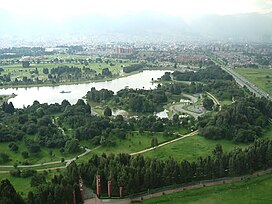The
Bolívar Square (Spanish: Plaza de Bolívar) is located in the heart of the historical area of
Bogotá. It has a statue of
Simón Bolívar sculpted in 1846 by the Italian
Pietro Tenerani, which was the first ever public monument in the city. Plaza Bolívar is also the name given to the main square in every city or town of
Venezuela, the native country of Simón Bolívar.
On the Northern side of the square is the
Palace of Justice, a big modern building where the
Supreme Court works. The history of the Justice Palace is tragic enough and maybe symbolic of the problems of the nation. The first building was built in 1921 on the corner of the 11th and with 6th street and destroyed by a fire during the
Bogotazo in April 1948. A new palace was built on the north side of the Bolívar Square and destroyed again in November 1985 by the guerrilla movement
M-19 during the "
Palace of Justice Siege", while the army tried to take control of the building. The ruins of the building were kept untouched for four years until the government decided to demolish them and construct the new building that currently exists.
On the southern side of the square the
National Capitol is located, which is the seat of the
Colombian Congress. Its construction was initiated in 1846 but due to the politic instability of the country it was not finished until 1926. This building was designed by the English architect Thomas Reed. The original design included a big dome. It was decided not to build the dome to finish the construction on time and not to defy the cathedral's tower.
On the north-east corner is the
Vase House, now also known as the Museum of the 20th July, in which occurred the
Call for Independence on July 20 of 1810, the first independence attempt from the
Spanish rule in
Colombia.
Finally, on the south-east corner is the
Mayor School of San Bartolomé, a secondary school institution, originally a
university, established by the
Jesuits in 1604, were many national personalities studied. The Camilo Torres little square is the place were some revolutionaries were killed in the Spanish re-conquest of 1816.




